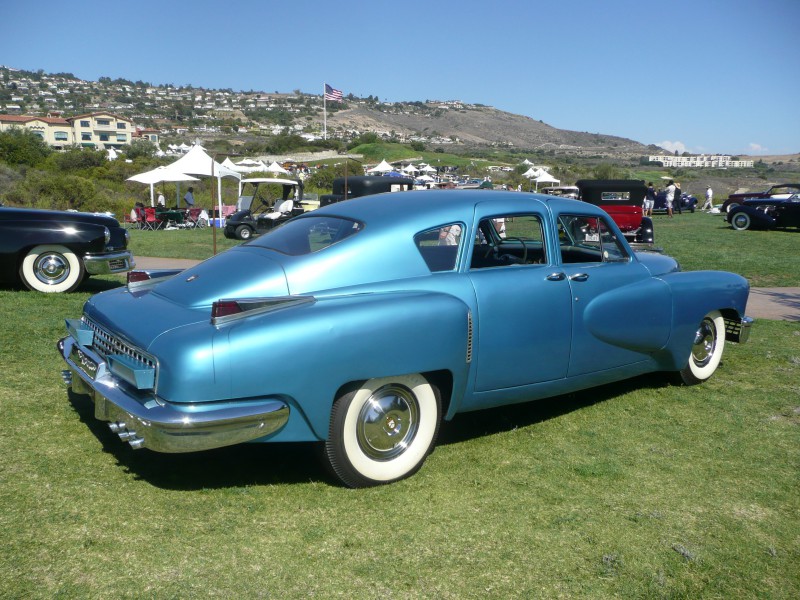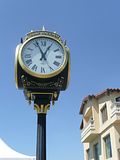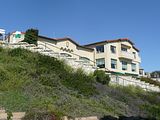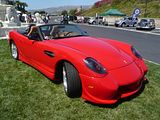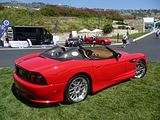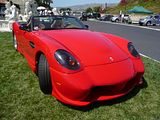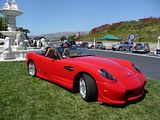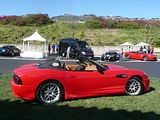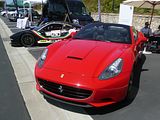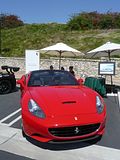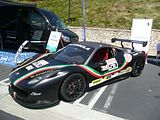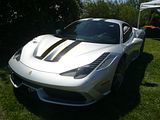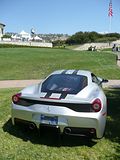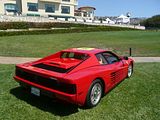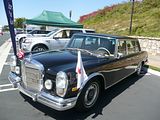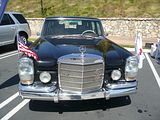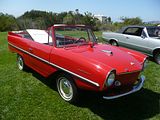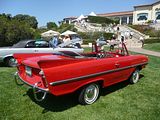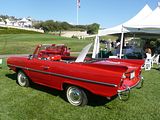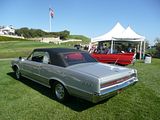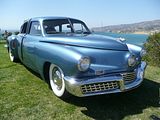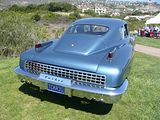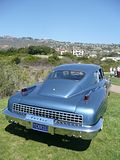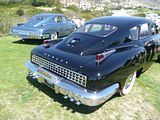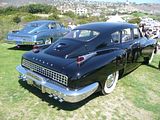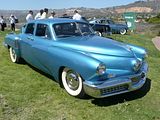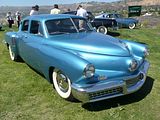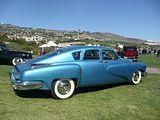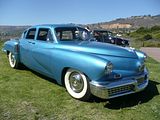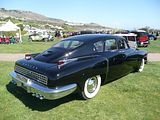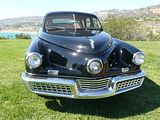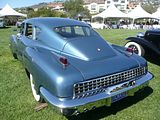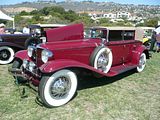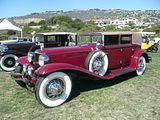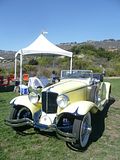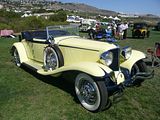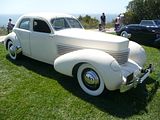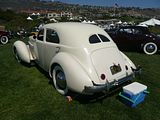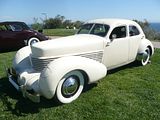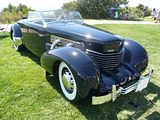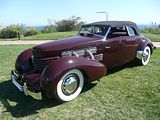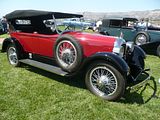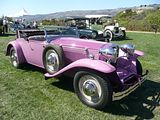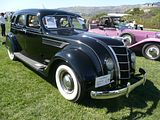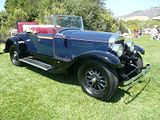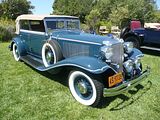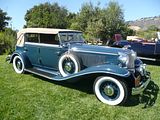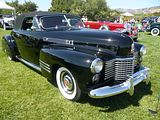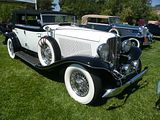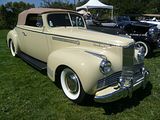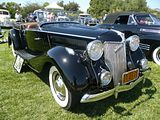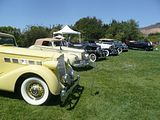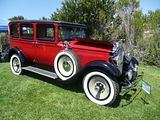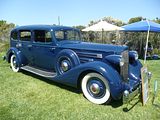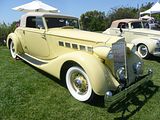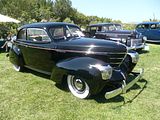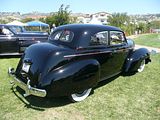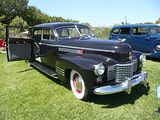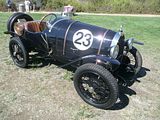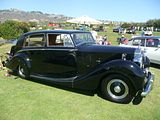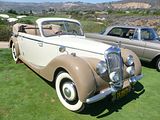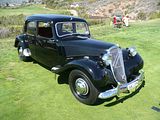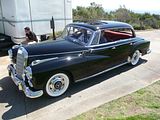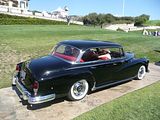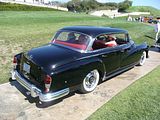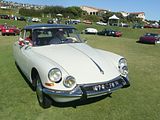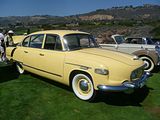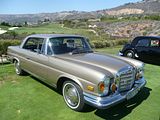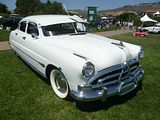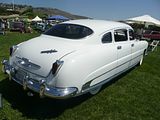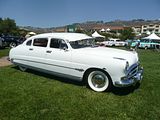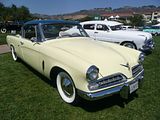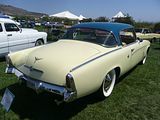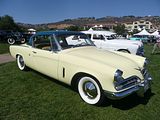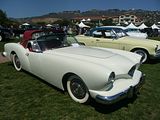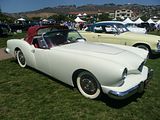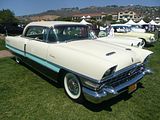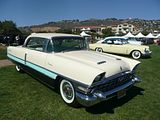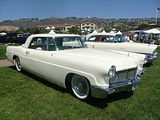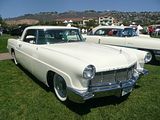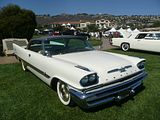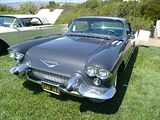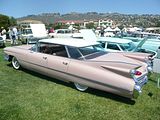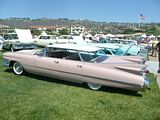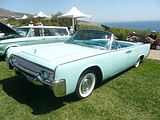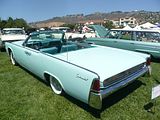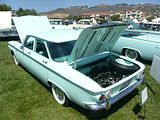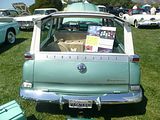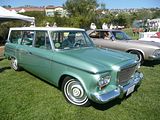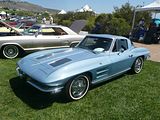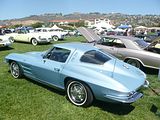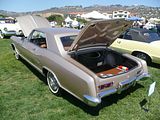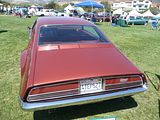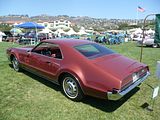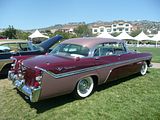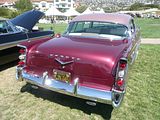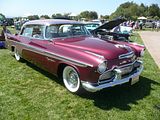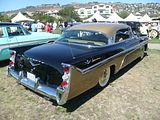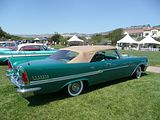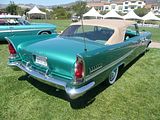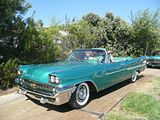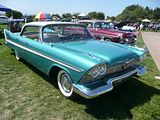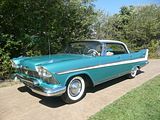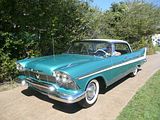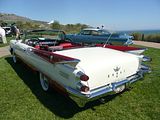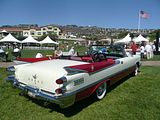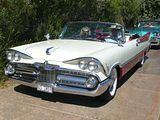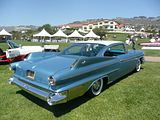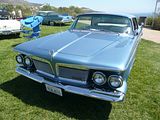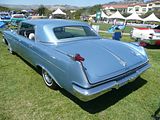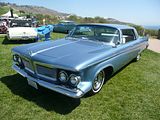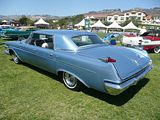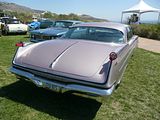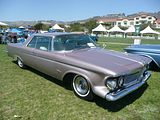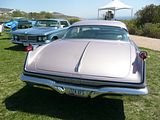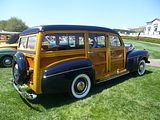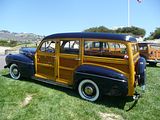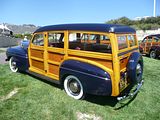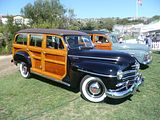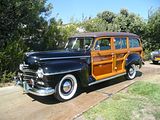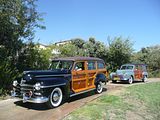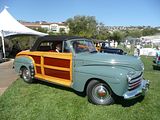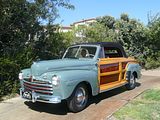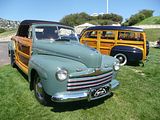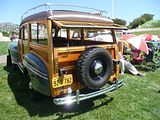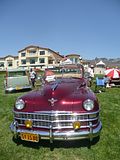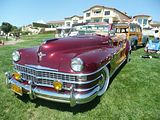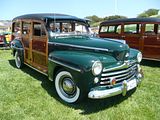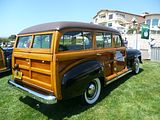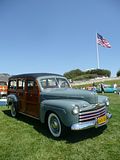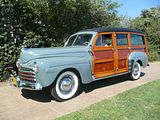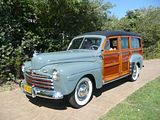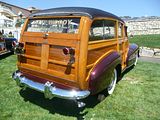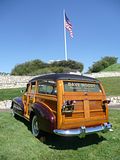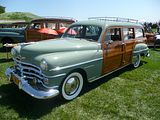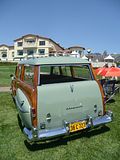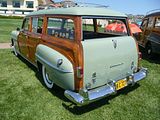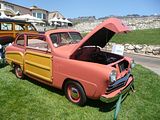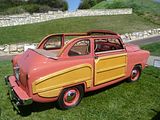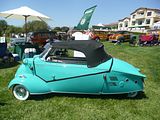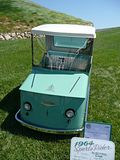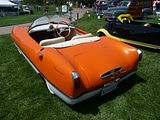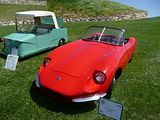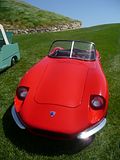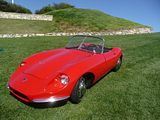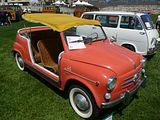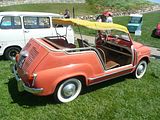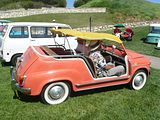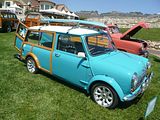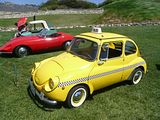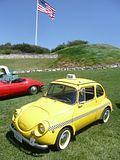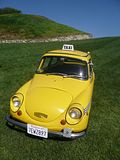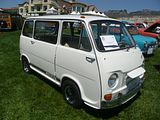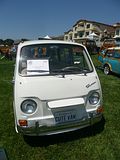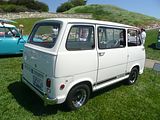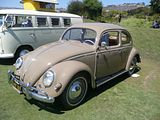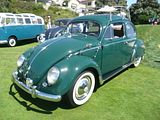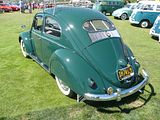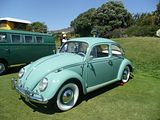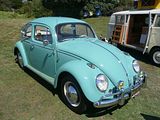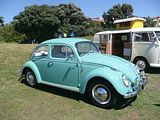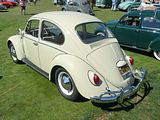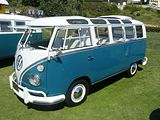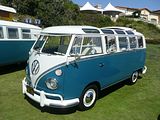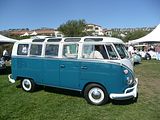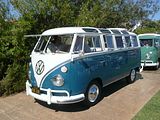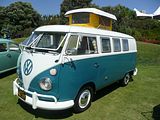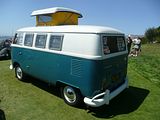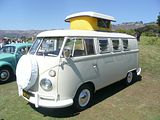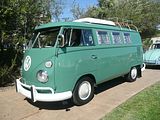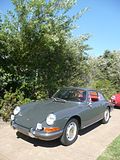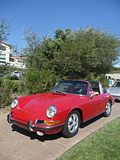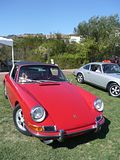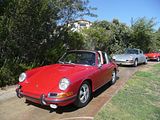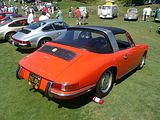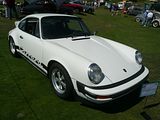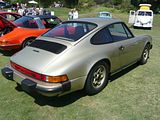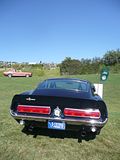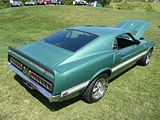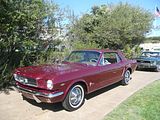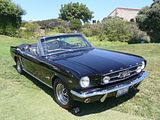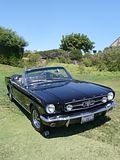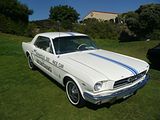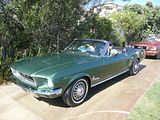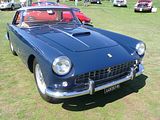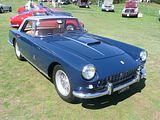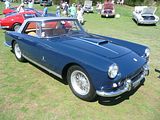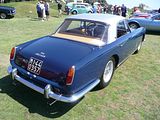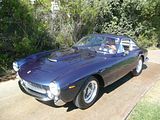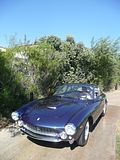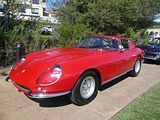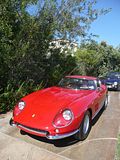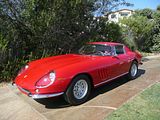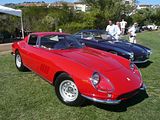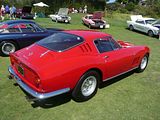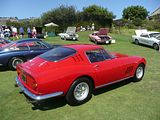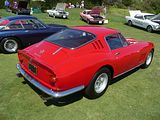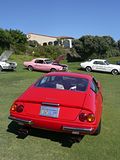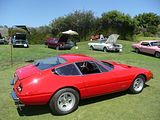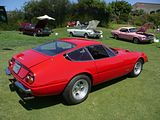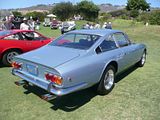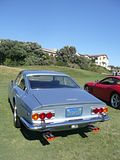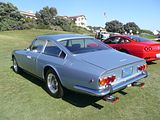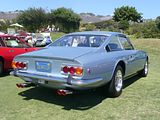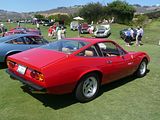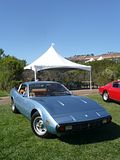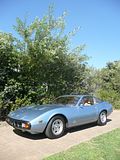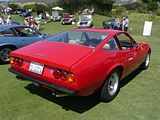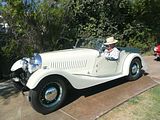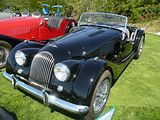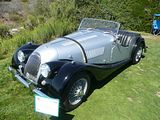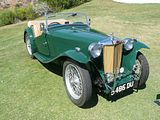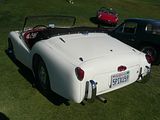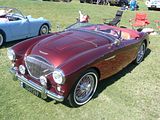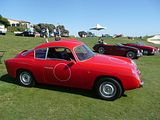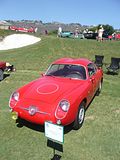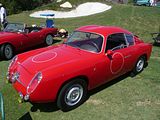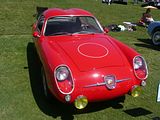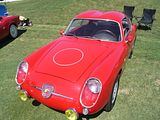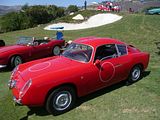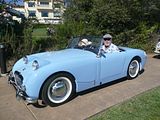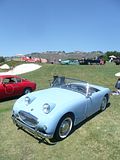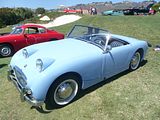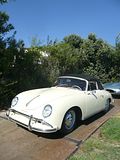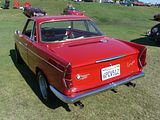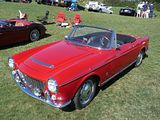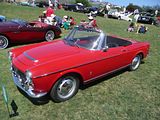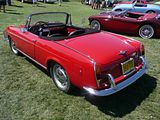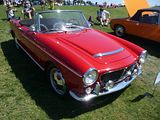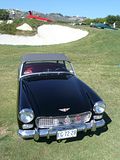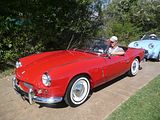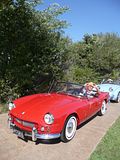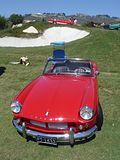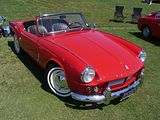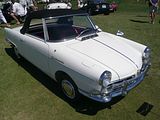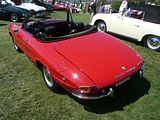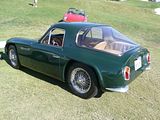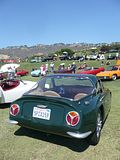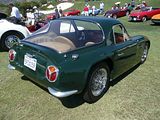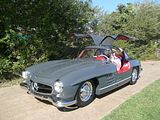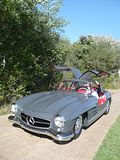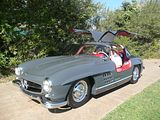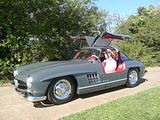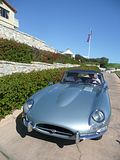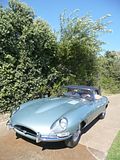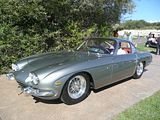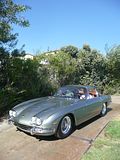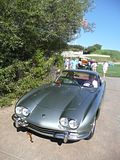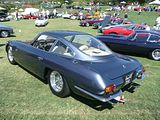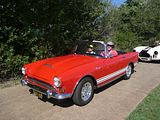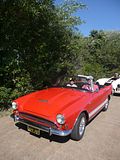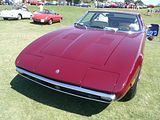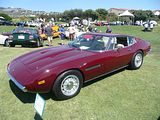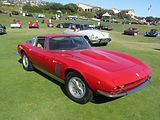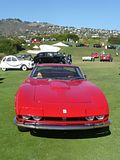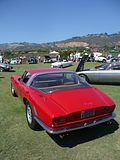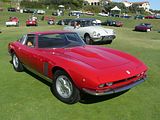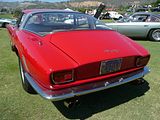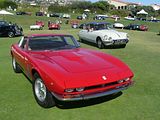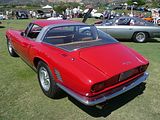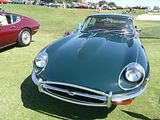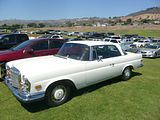I’ll admit that I’d never heard of the Palos Verdes Concours event, but thanks to a preview item I spotted on the “Classic and Sports Car” website, I did a bit of research, and discovered that this event was going to take place during my planned Sept vacation in Southern California, and moreover that Palos Verdes is right on the coast, just south of Redondo Beach, and therefore within the proverbial stone’s throw of where I would be staying. Tickets were available on-line at an advance price of $45, with a further $10 for car parking, which means that this is not that differently priced from the recent Hampton Court Concours of Elegance, but clearly this was going to be my chance to see a whole load of cars that live in America, and, if I was really lucky, to get a sort of “surrogate Pebble Beach” feel, without all the excesses that infest that event, and because it is SoCal, the likelihood of some splendid sunny weather. I think I got all of those, and a lot more besides.
It turns out that the event has been running for 22 years. It is held at Donald Trump’s rather exclusive Golf Club right on the Pacific coast, with stunning views of the sea an added bonus. However, it is the cars that I, along with a modest sized crowd had really come to see. These are scattered around some of the flatter parts of the course just down from the Club House, with a large central area reserved for the afternoon ceremony and parade of “winning” cars. Over 200 vehicles are entered, and these are grouped together into a vast number of classes, each of which only contains a few entrants. With the first three cars in each class invited to parade around the central arena and the winning car then to stay there, it took the best part of two hours to get through everything, and this was definitely part of the entertainment.
PANOZ
Before getting to the Concours cars, there were a few trade stands, but my eyes immediately set themselves on this. It is indeed a Panoz Esperante. Panoz is an American manufacturer of sports cars, founded in 1989 as Panoz Auto Development by Dan Panoz, son of pharmaceutical and motorsport mogul Don Panoz. The company is located in Braselton, Georgia. The first road car from the company was the Roadster, which was launched in 1992. Panoz had purchased the rights to a frame designed by Frank Costin used in a defunct Irish sportscar called the TMC Costin and so they Freeman Thomas design a new body for the car they wanted to build Aluminium body panels were produced by Superform USA, resulting in bodywork both light and strong. Ford Mustang running gear, engine, and transmission were used, as was a solid rear axle and independent front suspension. A seven man crew built the first ten cars, and other workers were added later to the production team. The Costin chassis was never put under a production car, instead the early Roadsters featured a TIG welded stainless steel tubing frame, and extensive use of CNC machined and stamped parts. The Roadster had no top or tonneau cover, and no provision or intention of having either. No automatic transmission was offered, only the manual 5-speed. A small heater core delivered warmth to the windshield for defrosting, since the US DOT requirements mandated it. There was no radio, no heater, no air conditioner, and further more no place to install any of those. Some Roadsters were fitted with a custom engraved plate atop the intake manifold with the owner’s name and the Panoz logo. A few cars were built to a factory specification, but most were custom ordered by the individual buyers. There were a number of changes that took place over the course of production, but in general the cars were quite similar. Roadster production continued to 1995. Two prototypes were built, and a further 44 cars were manufactured and sold to the public. The Roadster was succeeded by the AIV Roadster in 1997. AIV stood for Aluminium Intensive Vehicle, and this was the first American built car to be so. It was strikingly similar to the Plymouth Prowler first sold several years later. The new 4.6 litre engine produced 305 bhp and 300 lb/ft torque. Combined with the lighter chassis this increased the car’s power-to-weight ratio significantly. With the weight savings, an air conditioner was installed with little overall weight or performance change. The last year the AIV Roadster was made was 1999, when 10 were modified with special paint, supercharged, and signed to create the Signature Edition 2000 Panoz AIV Roadster. Total production of the AIV consisted of 6 prototypes and a further 176 production models sold to the public. Some cars built in 1999 were not sold until 2000. Replacement for the AIV was the Esperante Launched in 2000, there have been several different versions of the Esperante: base, GT, GTLM, GTS, and the JRD (an aftermarket upgrade brand similar to Roush Mustangs). Each model has different specifications. The GTLM, for example, uses a supercharger to boost power from 305 bhp to 420 bhp, raising performance from 0-62 mph in 5 seconds to 4 seconds. The GTS on the other hand is built as a driver’s class spec car, to SCCA standards, with harness, roll cage, side bars, etc. Additionally, it is 600 lb lighter than the base Esperante, has a steel 5.8 litre V8 racing engine that produces 385 bhp, and is made of easily replaceable panels to facilitate small impact race repair. It can do 0-60 mph in 4.2 seconds, go up to a top speed of 182 mph, and achieve 0.98 g of lateral grip.
It turned out that the reason why this Esperante had pride of place and would be among the first cars that visitors would see was because the guest of honour, presenting the prizes was none other than Don Panoz.
FERRARI
A duo of Ferrari were on the Ferrari South Bay dealer stand, a 458 Italia GT3 and a new California.
Other Ferrari models in this area included a brand new 458 Speciale and a Testarossa
MERCEDES-BENZ
The Mercedes-Benz Owners Club had a stand on which pride of place went to the very imposing W100 600 Pullman.
AMPHICAR
The Amphicar Model 770 is an amphibious automobile, the first such vehicle mass-produced for sale to the public, starting in 1961. The German vehicle was designed by Hans Trippel and manufactured by the Quandt Group at Lübeck and at Berlin-Borsigwalde. Its name is a portmanteau of “amphibious” and “car”. The Amphicar was designed to be marketed and sold in the USA. Compared to most boats or cars, its performance was modest, and only 4000 were produced by 1965. Nevertheless, it is still among the most successful amphibious civilian autos of all time, and still often prized and preserved as a novelty collectible automobile. This one was in splendid condition.
PONTIAC
Celebrating the 50th anniversary of the Pontiac GTO was this lovely 1965 GTO Convertible. This legend came into being when, in 1963, John DeLorean and two assistants were at the GM proving Grounds with the new 1964 Intermediate sized Pontiac, the Tempest and they spotted that the exterior dimensions and engine mounts of the car were the same for the proposed 326 cubic inch engine as those of the larger and more powerful 389 ci unit. Although Pontiac, along with most other major brands had been selling their large cars with optional, very powerful large displacement engines with multiple carburettors and four speed manual gearboxes for a couple of years, these long, wide and heavy cars did not handle well and looked like the cars that your grandparents drove. In a smaller, lighter car, though……….. the result, the 1964 GTO had a 325 bhp engine as standard and the option of an even more potent 348 bhp unit, a mean sounding dual exhaust, special wide-body tyres with distinctive red stripes, heavy duty suspension, metallic brake lining and lots of gauges. It was a hot rodder’s dream come true, and the start of the Muscle Car eraBy 1965, Buick, Chevrolet, Oldsmobile, Ford, Mercury, Dodge and Plymouth had established their own Muscle Car divisions and a continuous battle to produce ever more powerful cars began, but for many the GTO remains the most special of the lot.
THE CONCOURS
Although I thought I had got a photo of pretty much everything that was on show, when I came to matching what I had photographed against the entry list, there were a number of omissions. I’ve left in the article the full entry list, largely so readers here can judge the full extent of the event, even though it may be frustrating that a few cars remain undepicted.
TUCKER
There were three examples of the amazing 1948 Tucker. The Tucker was the realisation of the dreams of one man, Preston Tucker. He spent his time in the 1920s and 1930s with the automotive greats like Henry Ford and Harry Miller, earning his living in various engineering positions, as well as serving as a police officer and a time as a used car salesman. But he dreamed of revolutionising the car industry and during WW2, he began planning a radical car which he hoped would do just that. Based on a rear engined design with a focus on safety, he would tout his product as “the first completely new car in 50 years”. Certainly what he produced as “new” in many respects. Features such as doors that open into the rood, meaning no need for rain gutters were not seen on other cars for a long time afterwards, and the Cyclops central headlight that turned with the front wheels, the six exhaust outlets beneath the wide rear bumper and the full width grille were unique. The large, torpedo like styling, the work of young innovator called Alex Tremulis, who had been at Auburn-Cord-Duesenberg was certainly striking, too, Tucker hired many great engineers of the day, with Ben Parsons enlisted to develop Tucker’s proposed flat six engine, but time ran out and in the end Tucker purchased the Air Cooled Motor Company of Syracuse, New York and converted their flat 6 helicopter engine to water cooling for his car. All Tuckers featured a vacuum electric pre-selector type transmission, as fitted to pre-war Cord 810 models. Other innovations included seat belts. air cooled disc brakes, a pop-out windscreen of shatter-proof glass and a padded crash compartment. Sadly, it was all rather too ambitious and the money ran out. Just 51 of these cars were made, all in 1948. They are now highly prized by collectors, with an example recently being sold for $1.200,000. Most of them still exist today in displayable and driveable condition, but with several in museums, it is a very rare occurrence indeed that you will see three in the same place, but that was the treat of this event. One of the three is indeed from the nearby Petersen Museum, but the other two are privately owned, car number #1046 having been completely restored to factory spec following a past which saw the original engine replaced by a front mounted Oldsmobile Rocket V8 engine and the body being mounted on a 1964 Mercury Park Lane chassis.
CORD
The Cord was the brainchild of Errett Lobhan Cord, leader of the Auburn Automobile Company and builder of the transportation empire known as the Cord Corporation. Born in Missouri in 1894, and spending his childhood years in Los Angeles, Cord was crazy about cars from an early age. His first job, aged 17, was as a used car salesman, and ny the age of 20 he was working in a service station by day and at night building race cars. He quickly learned that cars with appealing style and powerful engines would essentially sell themselves, and this concept would serve him well in years to come. In 1920 he arrived in Chicago as a salesman for the Moon Motorcar Company, and he managed to improve sales performance of this now long forgotten brand by 60%, a fact which did not go un-noticed by the owners of the fast fading Auburn Automobile Company. Looking for someone to reverse their decline in fortunes, Cord was hired as General Manager. and moved to Auburn, Indiana in 1924. Cord’s enthusiasm helped the dealers to sell off the inventory which generated capital and which allowed Cord to embark on his dream of building a transportation empire. He took complete control in November 1925, a move which set him on course to produce two of the best loved 1930s Classic American cars, the L-29 and the 801. Influence for these icons came from the 1925 Indianapolis 500-mile race for which Henry Miller had built a revolutionary race car with front wheel drive, which finished second. Cord was intrigued. He could see that by not needing a drive shaft to the rear wheels, he could make a car lower, which would reduce wind resistance and make it handle better. Combine that with a low slung appearance, and he thought he could be on to a winner. Cord purchased Miller’s manufacturing rights and patents and built a prototype in 1927. He then commissioned Alan H Leamy to create a stunning body for his creation. Leamy wanted to produce a car as a single unit with the exterior, interior and mechanical aspects working together. The result was the Cord L-29, launched in July 1929 with four body styles: sedan, phaeton, cabriolet and brougham. This was the first front wheel drive car available to the American public. With prices ranging from $3095 to $3295, it was a competitor to the Cadillac, Pierce Arrow and Packard. Initial reaction was very favourable and sales were brisk. But in late October, the stock market crashed and most of Cord’s potential customers were financially ruined, Sales never really took off, and despite a price reduction of $700, L-29 production ended in 1931, with barely 5000 units having been made.
1930 Cord L29 Murphy Town Car
1931 Cord L29 Brougham
1932 Cord L29 Cabriolet
Desperate company executives wondered how they could rescue the Auburn Automobile Company and contemplated introducing a “baby Duesenberg” Renowned designer Gordon Buehrig was hired in the summer of 1934 to work on a prototype. As work progressed the concept changed to a technically advanced car with front wheel drive, independent suspension and front wheel drive and a radical new shape. The goal was to launch the car at the New York Auto Show in November 1935, as time was of the essence as the Auburn Automobile Company was on the verge of bankruptcy. The car took the Cord name, and was called the 810, It was a sensation, and orders poured in. Sadly, problems with the car and its manufacture meant that production did not get underway until into 1936 with the result that many customers withdrew their orders. Those who persisted soon fond that they had bought a car with more than a few teething problems For the 1937 model year, a supercharged engine, which boosted power from 125 bhp to 170, making the car a 100 mph cruiser. The Custom series had a longer wheelbase in response to customer demand for more space, but despite this and other running improvements, sales languished and the last production cars were made in August 1937. Barely 3000 of the 810 and 812 cars had been made. Many of the innovative features of the Cord would reappear in years to come in other cars. These days, these Cord models are well regarded as among the most stunning products of their era and it was good to see a number of them on show at this event.
1936 Cord 810 Westchester 4 Door Sedan
1937 Cord 812 Supercharged Custom Beverly Sedan
1937 Cord 812 Supercharged Cabriolet
1937 Cord 812 Supercharged Phaeton
DUESENBERG
1921 Duesenberg A Fleetwood Phaeton
1923 Duesenberg Model A
PRE WAR INNOVATION
1912 White 7 passenger Touring
1914 Rausch & Lang B4 Electric Brougham
1916 Franklin Sedan
1929 Ruxton Model C Roadster
1935 Chrysler Airflow
AMERICAN CLASSICS OPEN 1925 – 1934
1926 Cadillac Roadster
1931 Chrysler Imperial Waterhouse Victoria
1932 Chrysler CH Imperial Convertible Sedan
1932 Auburn V12 Boat-tail Speedster
1932 Jordan Playboy
1933 Cadillac V16 Victoria Convertible
1934 Auburn V12 1250 Phaeton
AMERICAN CLASSICS OPEN 1935 – 1948
1936 Packard 1404 Roadster Convertible
1936 Jensen 3.5 litre Tourer
1940 Lincoln Zephyr Continental
AMERICAN CLASSICS CLOSED 1925 – 1948
1929 Packard 626 5 passenger Sedan
1932 Franklin Victoria Brougham
1935 Packard 1208 Limousine
1937 Packard Super Eight
1939 Graham Sharknose Coupe
1941 Cadillac 75-19 Limousine
EUROPEAN CLASSICS 1925 – 1948
1922 Bugatti Type 23 “Brescia”
1927 Austin Seven Chummy
1934 Bentley 3.5 Litre Sports Saloon
1935 Hispano-Suiza J12 Cabriolet
1936 Bentley 4.5 litre
POST-WAR EUROPEAN
1947 Triumph 1800 Roadster
1950 Rolls-Royce Silver Wraith
1951 Riley RMD Drophead Coupe
1953 Delahaye 178 Chapron Cabriolet
1954 Citroen Traction Avant Light 11
1961 Mercedes 300d
1963 Rolls-Royce Silver Cloud 3
1964 Citroen ID19
1966 Tatra T603
1969 Mercedes 280SE Coupe
1980 Citroen 2CV “Beachcomber”
POST-WAR AMERICAN 1947 – 1958
1949 Cadillac Series 62 Coupe de Ville
1951 Hudson Hornet Sedan
1954 Studebaker Commander Starline Coupe
1954 Kaiser Darrin
1955 Pontiac Star Chief Custom Catalina
1056 Packard Caribbean Hardtop
1956 Lincoln Continental Mark 2
1957 de Soto Adventurer
1957 Ford Skyliner
1958 Cadillac Eldorado Brougham
POST WAR AMERICAN 1959 – 1966
1959 Cadillac Sedan de Ville
1961 Lincoln Continental Convertible
1961 Chevrolet Corvair 700 Sedan
1963 Studebaker Wagonnaire
1963 Chevrolet Corvette
1964 Buick Riviera
1965 Pontiac GTO Convertible
1966 Ford Mustang GT Fastback
1966 Oldsmobile Toronado deLuxe
VIRGIL EXNER CHRYSLER DESIGN
Hired by Chrysler Corporation in 1949, Virgil Exner became one of the automotive industry’s best known design innovators and his leadership had a profound impact on Chrysler and indeed the entire industry. Exner founded the Chrysler Advanced Styling Studio and he produced a series of concept show cars, often several a year, from 1952 to 191. These “Idea Cars”, built in Italy by Ghia were featured in Chrysler’s advertising promotions, and they became sensations, making Exner a household name, not something which usually applied to an automobile stylist. In 1952, Exner was given the task of revising the entire 1955 product lineup and he had just 18 months to come up with something. Until this time, engineers had been responsible for styling at Chrysler, but with full authority for these models given to Exner, not only did he become the Corporation’s first Director of Styling, but he changed the way that styling was done, by recruiting some of the designers out there, building up a styling department of 300 people. Those 1955 cars were launched under the label “the Million Dollar Look”, and the cars were lower, sleeker, more modern and handsome and distinctively different from anything that GM and Ford could offer. Sales increased dramatically, which was, of course the goal. Exner’s team were responsible not just for the look inside and out, but also selected the paint colours and they devised a radical palette of single, two-tone and tri-tone colours in bright hues and with bold names such as Fantasy Yellow , Tango red and Tampa Turquoise. Interiors were similarly bold and bright, trimmed in fabric, vinyl, leather or some combination. Although it was GM who first showed a tailfin on the 1948 Cadillac, it was Exner who popularised this feature by adopting it across the entire 1956 range, and by so doing, he was able to make a dramatic change to the look of the cars with a limited design budget. It is well documented that GM’s then styling chief, Bill Mitchell spotted some pre-production 1957 models, and was so impressed by them that he made his team completely redo their proposed 1958 and 1959 models in an effort to regain styling leadership. Advertised as “Suddenly it is 1960”, the 1957 models were a real sensation. Longer, lower and wider, they made the Fords and GM cars look very old fashioned and Chrysler’s market share soared to 21%, a high water mark that they would never achieve again. All Chryslers for that year had soaring tail fins, uniquely designed for each of the 5 brands of Chrysler, Plymouth, Dodge, DeSoto and Imperial. There were plenty of other innovations, to, with push-button controls for almost everything, electro-luminescent instruments, “highway hi-fi” record players, swivel seats that turned outwards when the door was opened, quite apart from the legendary Hemi engines. Exner had a heart attack in 1956, but when he returned, he took responsibility for the 1961 models, but this was no easy task as whilst he had been off, a temporary manager had deliberately taken the design in a different direction and the resulting confusion and in-fighting meant that the production cars lacked what had been so successful in his earlier designs. Although he was able to make amends with the 1962 and 1963 cars, the 1961 cars did not sell that well, and Exner was replaced during that year. A period of more conservative and slab-styled styling followed. There’s not really been anything quite so dramatic or forward thinking since. The array of cars from the Exner era which were here were among my favourites of the whole event – some truly magnificent machinery.
1955 Chrysler 300 NASCAR
1955 de Soto Fireflite Coronado
1956 de Soto Fireflite Sportsman
1956 de Soto Adventurer
1958 Chrysler New Yorker
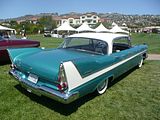
1958 Chrysler New Yorker Convertible
1958 Dodge Royal Lancer
1958 Plymouth Belvedere
1959 Dodge Royal Custom Lancer Super
1962 Imperial LeBaron 4 Door Southampton
1962 Imperial Crown Southampton
AMERICAN WOODIES 1929 – 1951
The use of wood in automobile manufacturing stems from the horse and cart days, when just about everything was built using this material. Consequently, there were plenty of skills in using wood, so when there were requirements for small scale or coachbuilt bodies, then wood was an obvious potential material to use. Early “station wagons” were so-called as they were used to transports guests from railway stations to nearby hotels, and the vehicles with this labels were typically manufactured as third party constructions of regular vehicles, some created by large and reputable coach-building firms and others by local carpenters and craftsmen for individual customers. They tended to be quite austere vehicles with flat glass and canvas side curtains, and they were sold in limited quantities. They were particularly popular in America, and from the late 1920s began to be produced in greater quantity. In 1929. Ford began to produce “woodie”, as these wood-bodied vehicles had been christened, on a regular production line, and public interest in this style rapidly grew. With a certain public interest in the “woodie”, for the next 25 years or so, all the major US manufacturers produced this type of vehicle as variants of regular sedans and convertibles as well as station wagons, some more luxuriously finished than others, with Chrysler’s high end Town and Country and Ford’s 1946 – 1948 Sportsman being notable examples of woodies that are not station wagons. In 1951, Plymouth discontinued their woodie station wagon, replacing it with an all-steel model, and by 1953, Buick was the only marque still to be producing woodie models. Weight, strength, cost and durability of all steel bodies triumphed over those made with wood, and many found that the woodie was just too expensive to maintain. Moisture caused rot and accident repairs were difficult, and most owners put off the routine re-varnishing that was required These vehicles quickly became inexpensive, shunned by most buyers, which is where in the early 1960s, the surfing fraternity came in. They discovered that they could buy a vehicle that was perfect for carrying their long surf-boards for not much money. Soon, these vehicles were popular again. but the days of them being cheap are long gone. Nowadays, with the high cost of looking after the wood, these are high end vehicles, lovingly preserved. Some truly splendid examples were on show here, making for a particularly impressive display.
1940 Ford Station Wagon Woodie
1941 Mercury Woodie Station Wagon
1946 Ford Sportsman
1947 Mercury Harmon-Herrington Station Wagon
1947 Chrysler Town & Country Woodie Convertible
1947 Ford Woodie Station Wagon
1947 Plymouth P-15 Super de Luxe Woodie
1948 Ford Station Wagon Woodie
1948 Oldsmobile Station Wagon Woodie
1950 Chrysler Royal Wagon Woodie
MICROCARS
1950 Crosley Woodie Convertible
1955 Messerschmitt Sport Convertible
1964 Sports Rider Electric Car
1958 Isetta 300
1959 Goggomobil Dart
1962 Saab Quantum
1962 Fiat 600 Jolly
1965 Austin Mini Countryman
1970 Subaru 360
1970 Subaru 360 Van
VOLKSWAGEN
1953 Beetle
1953 Beetle
1954 Beetle

1955 Beetle Convertible
1956 Beetle
1962 Beetle
1962 Beetle
1966 Beetle
1966 21 window Bus
1966 Camper Westfalia
1967 Camper Westfalia
1967 Camper Westfalia
PORSCHE
Needing no introduction, Porsche’s legendary 911 celebrated its 50th anniversary in 2013, with an array of events around the world marking the success of what started out simply as a replacement for Porsche’s long running 356 model. First shown at the 1963 Frankfurt Show, the 911 was a careful evolution from the car which had established Ferdinand Porsche’s eponymous company on the map in the 1950s. Starting out as a 2 + 2 coupe with an air cooled flat six 2 litre engine in the rear of the car, producing 148 bhp, this elegant design was not inexpensive, but it was well engineered and when production started in 1964, sales were solid. Around 6200 of them were bought in America in the first year it was available, and that has remained the total number of units bought every year since. Porsche did not rest on their laurels, producing a continuous stream of updates and new models, starting with the launch of the 180 bhp 911S in late 1966 and quickly followed up by the 1967 Targa model. By 1969 the 911S., now with fuel injection, had increased its power to 190 bhp, and a 2.3″ longer wheelbase had been introduced to try to contain the effects of the infamous oversteer which meant that many owners had spun their cars as they discovered that although at normal driving speeds this was one of the best handling cars on sale, there was a point when the 911 could and probably would bite back. Continuous development of the car on the road and the race track saw a couple of iconic models launched in the mid 1970s: the 1973 911RS Carrera and the 1975 911 Turbo. The former was built as a homologation special, and featured a larger 2.7 litre engine, wider track, a ducktail spoiler and was lightened to improve performance. More than three times the required number of cars were built, a total of 1580 cars. There were several examples of these early 911s car to enjoy at this event. .
1966 911
1967 911S Targa
1973 911S
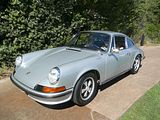
1974 911 Carrera RS
1975 911S Silver Anniversary Edition
1976 911 S
SHELBY AMERICAN
1965 Shelby Cobra 427
1965 Shelby Cobra
1965 Shelby Cobra 289
1965 Shelby Mustang GT350
1966 Shelby Cobra Roadster 427
1968 Shelby Mustang GT500KR Convertible
1969 Shelby Mustang GT350
1970 Shelby Mustang GT500
MUSTANG
Another of those cars that needs no introduction, the Mustang celebrated its 50th birthday earlier this year, and there have been events and tributes the world over to mark this. The car was launched at the New York World Fair on 13th April 1964, and it was just the sort of sensation that Lee Iacocca’s team had hoped they could create. Indeed, it was immediately obvious that this youthful and sporty car, intended to be produced at the rate of 85,000 cars a year would surpass all expectations and with huge crowds of people gathering everywhere the car appeared, production volumes were quickly raised to 200,000. All sorts of tales emerged about how dealers had to lick their showroom doors to keep the mob of customers fighting over the last car available at bay, how a prospective customer slept in the car in the showroom until his cheque cleared and so on. Brilliant though the initial car was, Ford followed with a program of continuous change and improvement to keep the car fresh and with something new to interest buyers, something which has been true for all 50 years that cars bearing the name have been produced. New editions, colours and modifications to the body all came in quick succession, but it was the involvement of former racer Carrol Shelby which was unquestionably the most important coup of all. By early 1964, Shelby’s company, Shelby American had become an extension of Ford’s road racing program. With a plan to improve the Mustang’s racing and performance image, Shelby designed and created a new engine for the Mustang, and added the GT350 to the range in 1965, and yet again, Ford had a sensation on their hands. By 1966 more than 1 million Mustangs were on America’s roads and the car became “cool” to have, even though it was relatively cheap by the standards of what else was on the market. Since then, four further distinct model generations have followed, with the Mark 2, the least well liked model, appearing for 1974, and legendary names such as Mach 1, Cobra 11, King Cobra, Fox and SuperSnake are just many of the emotive model variants on offer. This class was made up of models from the first few years production.
1964.5 Mustang Coupe
1965 Mustang Convertible
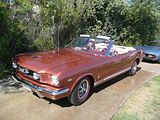

1967 Mustang Coupe
1968 Mustang GT390 Convertible
1970 Mustang Grande
FERRARI
1959 250GT Coupe
1964 250 GT/L Lusso
1967 275GTB/4
1971 365 GTB/4 Daytona
1971 365 GT 2+2
2002 575M Maranello
MORGAN
1951 DHC
1952 Plus 4
1961 Plus 4 Roadster
1964 Plus 4 SuperSport
1965 Plus 4
EUROPEAN SPORTS CARS under 3 Litres
1948 MG TC
1954 Triumph TR2
1955 Austin-Healey 100 le Mans
1957 Abarth Zagato 750 GT Corsa
1958 Austin Healey Sprite
1959 Porsche 356 T2 Cabriolet
1960 BMW 700 RS
1960 BMW 700 Coupe
1963 Fiat 1500 Osca
1962 Austin Healey Sprite Mark 2
1963 Triumph Spitfire
1966 NSU Wankel Spider
1967 Alfa Romeo 1600 Spider
1967 TVR 1800S Mark IV
1970 VW/Porsche 914-6
EUROPEAN SPORTS CARS over 3 Litres
1951 Allard K2
1957 Mercedes 300SL Gullwing
1962 Jaguar E Type 3.8 litre
1965 Lamborghini 350GT
1966 Jaguar E Type 4.2 FHC
1967 Sunbeam Tiger Series 2
1969 Maserati Ghibli
1970 Iso Grifo
1971 Jaguar E Type FHC Series 2
1975 Lamborghini Urraco
IN THE CAR PARK
I came across this rather nice W111 Mercedes 280 SE Coupe on the route between my car and the entrance to the event.
By the time I was ready to leave, the public car park had emptied out, so there were not that many cars left. I did not really have to wander round them to see if there was anything of interest, as I could see that with the exception of this pair of cars, there was not! So, only an Aston-Martin Vanquish and a Ford Ranchero to enjoy.
I had not been quite sure what to expect, but this turned out to be a great event, which I very much enjoyed. It’s certainly worth including in your schedule if you happen to be in the Los Angeles area at the right time in September.

